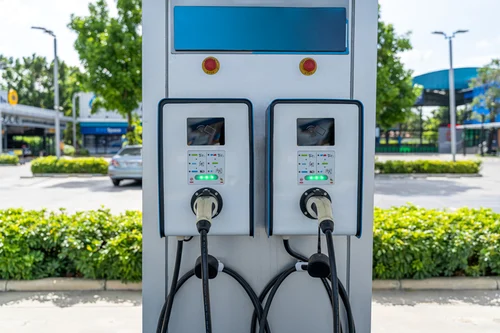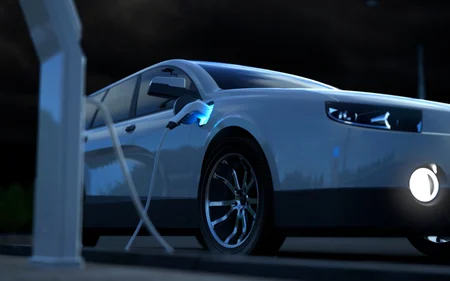Thermal management has been a concern for as long as engines have propelled vehicles. Vehicle temperature has always been central to performance and safety, with poor thermal control risking anything from overheating to fire.
A shift from fossil fuels to electricity is transforming transport, with EVs already becoming a common sight on the roads. It will be some time before all modes of transportation are electrified, but fully electric vehicles (EVs) are already starting to dominate roadways.
Experts predict EVs could overtake petrol and diesel vehicles within a few years, with battery-powered aircraft, boats, and trains following close behind. Like their fossil fuel-powered counterparts, thermal management for EVs is essential, arguably more so.
Thermal management for EVs, primarily their batteries, has been a major barrier to making an alternative vehicle type viable. Mass charging infrastructure and range have also been ongoing issues.
Advances in thermal systems have allowed EVs to perform reliably, whether on short errands or long-distance journeys. They continue to ensure the next generation of transportation remains safe and dependable.
Despite their growing capability, EVs still need carefully controlled operating temperatures to ensure long life and peak performance.
Thermal runaway in a battery pack presents new hazards for drivers, passengers, and emergency crews. Rapid, accurate, and responsive thermal management systems are essential for vehicle design, from the engine block to the battery pack.
Six Places for Electric Car Temperature Sensors in Vehicle Design
Like an internal combustion engine (ICE) vehicle, excessive heat can severely affect an EV’s safety, functionality, and useful life. In an EV, temperature sensors serve more roles than in conventional cars, as more components are sensitive to heat extremes.
Outside of their obvious role in the EV battery pack, six places can significantly benefit from temperature sensor placement.
The Motor
EV motors feature many components working seamlessly together, much like the engines of ICE vehicles. Most importantly, EV motors get hot when in use.
To run efficiently, an EV motor must be kept between 90 °C and 95 °C. Temperatures outside of this range can cause reduced efficiency or forced safe-mode operation due to overheating.
Electric vehicle temperature sensors should be installed in the motor to monitor:
- Electric motor oil temperature
- Electric motor winding temperature
- Electric motor coolant temperature
However, electric motor temperature control is not always concerned with keeping temperatures down. In colder climates, motor temperatures must be brought up to around 15 °C before driving to ensure efficient operation.
The Inverter
Inverters control the lifeblood of an electric vehicle, acting as the channel through which DC energy is converted to AC to power the motor. Although inverters convert DC to AC power for the motor, unchecked heat can quickly push them beyond safe 150 °C limits and cause component failure.
Interior components start to fail when exposed to excessive heat for too long, resulting in the device failing to function properly. Typical effects of overheating on inverters include:
- Insulation degradation
- Solder cracking
- Metal warping
The Charger Handle and Port
The EV charger’s handle and charging port can also overheat due to their role as the source of an EV’s power. High temperatures may be indicative of:
- Poor connection
- Charger malfunction
As fast-charging becomes standard, monitoring heat at the charging port is vital to avoid faults and maintain efficiency. Fast-charge technology has already decreased re-energizing times to just 30 minutes for 80 % power, but consumers continue to look for a refueling experience similar to filling a traditional gas tank.
Fast charging requires the conversion of a large amount of power, generating a significant amount of heat. As the technology improves and delivers ever-more-rapid recharging times, it will be important to monitor temperatures to ensure the process remains safe and efficient.
The Thermal Management System
A thermal management system’s base function is to regulate an EV’s battery and mechanical components, but the system itself also needs monitoring.
The temperature of the thermal management system directly affects the EV components it is designed to cool. For example, temperatures spiking beyond normal ranges may trigger a domino effect, causing issues with other components.
Temperature sensors monitoring critical points in both coolant and refrigerant systems pass critical sensor information to system controllers to optimize performance and minimize power consumption while maintaining appropriate system temperatures.
High temperatures within the thermal management system can indicate leaks, faults, or overloaded cooling components.
The Passenger Cabin
A vehicle that is too cold or too hot will be uncomfortable for drivers and passengers. Outside the EV’s motor, the HVAC system is the next-most noticeable thing running while an electric vehicle is on.
Efficiency is the cornerstone of an electric vehicle’s functionality, and it is vital that an EV uses no more power than is absolutely necessary. Electric vehicle sensors tell the car and computer precisely how hard the vehicle’s systems must work to maintain this efficiency.
In-cabin EV HVAC system temperature sensors ensure drivers and passengers remain comfortable without draining the battery too fast and reducing the EV’s range.
Under the Hood
The role of exterior temperature sensors extends beyond informing drivers and passengers of the climate outside the vehicle.
Like an in-cabin HVAC temperature sensor, an external sensor lets the vehicle know how hard some of its other systems have to work to respond to environmental temperatures, for example, the thermal management system. Outside temperature sensors are generally installed under the hood of a truck or car.
Fast Charging and Electric Vehicle Sensors
The ability to safely get from point A to point B is widely regarded as the primary function of any vehicle, so a vehicle must be ready to be driven when its owner wants to use it. Like an empty tank of gas, a depleted EV battery is the last thing an owner wants to see.

Image Credit: Amphenol Sensors
Electric vehicles leverage a different fuel source than their conventional combustion engine counterparts, but that does not change an owner’s expectation that their vehicle, or fleet of vehicles, is always available for immediate, on-demand transportation.
Despite advances in battery technology, there remains a misconception that electric vehicles run out of power at the most inconvenient time or when the driver is far away from a charging station. Gas-powered vehicle owners are used to the refueling process taking just a few minutes. Still, questions remain around how charging an electric vehicle can approach that level of speed and convenience.
Combining longer-lasting power banks and fast-charging EV technology addresses these concerns, allowing EVs to keep pace with trucks and cars running on fossil fuels.
Despite fast-charging technology and charging station infrastructure, EV consumers must still overcome worries about time lost re-energizing. Results matter to those looking for a seamless transition to driving an electric vehicle, meaning that electric vehicle sensors are key to making charging almost as fast as refueling at a gas station.
Fast Charging’s Potential Impact on EV Battery Health
Fast-charging systems are making the conversion to electric vehicles more practical, but it is essential that these are used with proper monitoring because the primary by-product of fast charging is heat, particularly when converting electrical current from AC to DC.
Using Electric Vehicle Sensors to Monitor Fast Charging
Sensor technology is key to ensuring that high-speed EV charging is safe and efficient. Fast charging requires rapid-response sensors, most notably vehicle temperature sensors.
The risk of heat damage to an EV’s components increases significantly without real-time monitoring that triggers systems designed to maintain ideal temperatures. There are three places in an electric vehicle where temperature sensors are essential for fast charging.
The Point of Connection
Temperature sensors are essential at the charging port and the charging handle.
Many electrons must pass rapidly from the EV service equipment to the vehicle battery to charge it quickly. This high current generates heat, meaning that high temperatures within the charging port can potentially indicate a poor connection between the EV’s contacts and the charging handle.
In terms of efficiency, a poor connection means the vehicle is not charging as fast as it should be. High temperatures from an EV fast charger’s connector are also indicative of a malfunction, or the charger being overtaxed by the power demand.
The Thermal Management System
Overheating within an EV’s thermal management system represents a clear sign that the system’s components are running hot and it is not working as intended. These include:
- Heat exchangers
- Cooling plates
- Coolant fluids
- Refrigerants
- Dielectric oils
Excessive temperatures are also a signal that the EV cooling system may be overwhelmed by excessive heat from the parts the system should be cooling.
The Battery
Lithium-ion batteries charge most efficiently between 45 °C and 60 °C, and risk overheating, shutdown, or thermal runaway if temperatures rise above this limit. In-pack temperatures extending beyond this range can cause the vehicle to go into safe mode and shut down, or worse, begin the thermal runaway process.
An overheating battery is one of the final indicators that something is wrong with the vehicle’s charging or thermal management systems, or that the battery itself is not functioning correctly. Under these circumstances, immediate cooling is essential to maintain the battery’s long-term functionality and safety.
The Future of EV Fast Charging
Fast-charging technology continues to evolve. Existing fast-charging technology takes approximately 30 minutes to re-energize an EV's battery to 80 %, but engineers are continually working to make fully charging an EV as quick and easy as filling up an ICE vehicle’s empty gas tank, a process that generally takes under 10 minutes.

Image Credit: Amphenol Sensors
Demand for ultra-fast electric vehicle charging is not wholly driven by the need for convenience, however. Ultra-fast charging is being driven not only by convenience, but by the needs of heavy-duty fleets to minimise downtime.
This is because larger vehicles have battery packs several times bigger than those installed in electric cars. These larger battery packs take longer to charge, but this increased time spent charging represents lost income and productivity.
Rapid-response sensors designed to monitor heat throughout an EV are key to:
- Putting vehicles back in service faster
- Preventing battery degradation or damage
Electrification represents one of the most significant transitions in the history of transportation, but vehicle owners and operators still expect functionality and efficiency. Fast-charging technology is enabling this shift by directly addressing a major concern.
EV Thermal Management
Electric vehicle sensors are fundamental to making EV charging as uneventful as filling up a gas tank.
The literal power behind vehicles is now changing the way that people travel, and robust, reliable, and responsive sensor technology is at the forefront of keeping vehicles running efficiently and safely.
As the natural by-product of using an EV, an incident of uncontrolled excessive heat in an electric car, truck, or any other vehicle has the potential to effectively derail the electrification revolution. Consumer protection agencies and consumers themselves have long memories when it comes to mischaracterized performance or safety failures.
An electric vehicle’s performance is hardly distinguishable from their soon-to-be phased out fossil fuel-powered predecessors. Effective sensor integration enables EVs to match the safety and dependability expected from the vehicles they are replacing.
Acknowledgments
Produced from materials originally authored by Amphenol Sensors.

This information has been sourced, reviewed and adapted from materials provided by Amphenol Sensors.
For more information on this source, please visit Amphenol Sensors.